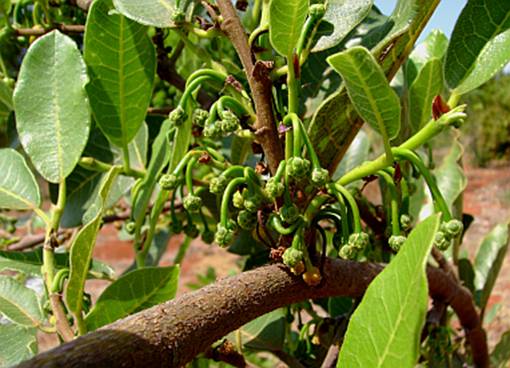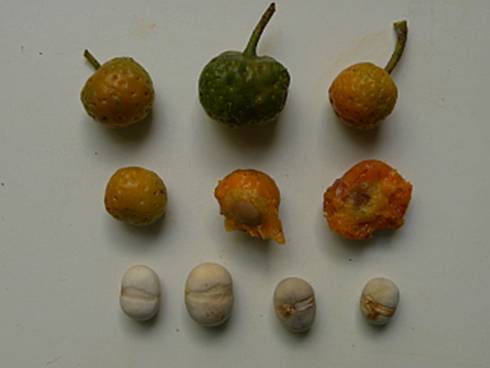BROSIMUM GAUDICHAUDII
FAMILY OF MORACEAE
|
|
|
|
FLOWERS |
MATURE FRUITS |
NOMENCLATURE AND MEANING: Apinima comes from the Tupi Guarani and means "painted fruit" or Myrá-pinima “varnished wood”, the characteristics are clearly visible in this species. Also named as mama-cadela, Manacá do campo, or chiclete do cerrado.
Origin: Very frequent occuring in the savannahs from Amazônia to the state of Paraná, Brazil. More informations in the Portuguese language under the link:
Features: Small tree of the size of 2 to 5 meters with long, flexible branches, important characteristic by the dripping of latex when the bark is injured. The leaves are oblong (longer than wide), leathery (stiff consistency), fluffy (covered with fuzz) and with protruding ribs, 5 to 13 cm long and 2 to 4 cm wide. The male flowers are numerous, with a stamen and the female flowers are spherical with honey glands, and the two scars are obtaining pollen, clusters with numerous flowers of both sexes are formed.
Culture Tips: Slow-growing tree thrives in any well drained soil with good fertility in very sunny locations. It can be grown in whole Brazil, because it resists freezing to -2°C and not too long periods of drought. Thrives also in rocky soils.
Propagation: The seeds are large and round and quickly lose their ability to germinate. It is best to plant in individual containers with a sandy substrate. Germination usually takes 40 to 60 days, the seedlings reach 30 cm in the age of 9 months and appreciate a sunny place for development. The fruit will begin from the age of 4 to 6 years, depending on soil and culture.
Planting: They can be planted in full sun or in mixed reforestation, because of the fruits that feed many birds and animals. In the orchard, the planting distance should be 4 x 4 m, the deep holes should be filled of 30% organic matter and 30% sand and clay. Water during the first 2 months, with 10 liters of water per week and cover the bottom surface with dry grass or sawdust, to maintain the moisture.
Culture: Trimming the crown and removing branches that grow from the base of the trunk. Fertilize with compost, it can be 5 kg poultry manure mixed well with 30 g of NPK 10-10-10. Twice the amount every year to the fourth year.
Use: Fruiting from October to December. The ripe fruits turn yellow and orange and are very sweet, the pulp is chewed like gum. They can be eaten in kind and in the form of sweets and ice cream.
Back to the seedlist (English) or back to Moraceae (Portuguese)

